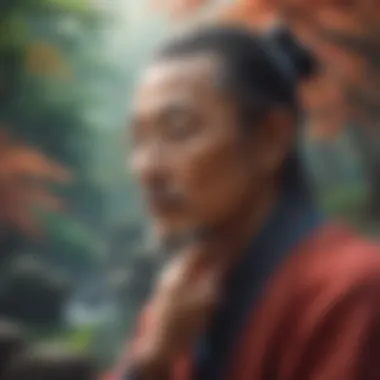Insights and Free Access to the Tao Te Ching


Intro
The Tao Te Ching, a cornerstone of Eastern philosophy, resonates with deep significance for many who seek guidance in their lives. This ancient text, attributed to Laozi, is more than just a book; it's a roadmap for living in harmony with the natural world. Its teachings evoke contemplation and challenge conventional perspectives on existence, urging readers to explore a balance between thought and being. In this modern age where stress and hurried lifestyles reign, the insights from the Tao Te Ching can provide a much-needed antidote.
This article undertakes an expansive journey through the Tao Te Ching, analyzing its fundamental themes, philosophical underpinnings, and practical benefits. By offering ways to access this treasure trove of wisdom for free, we aim to shed light on how it influences personal development and spiritual attainment. We'll delve into its main ideas, practical applications, and further reading recommendations to enrich your understanding and engage with these teachings meaningfully.
Key Concepts and Insights
Main Ideas from the Book
The Tao Te Ching embodies various concepts that echo throughout its verses. Central to its philosophy are the ideas of Wu Wei, which translates to "non-action" or, more accurately, "effortless action." This principle isn't about inaction but rather about aligning oneself with the natural flow of the universe. Laozi encourages embracing simplicity and spontaneity in navigating life's challenges.
Additionally, the concept of Tao, or the "Path," serves as an overarching theme. Understanding the Tao means recognizing the inherent nature of reality. It's not something to be grasped but experienced; it's an invitation to immerse oneself in the present moment without clinging to preconceived notions.
Through reflective poetry, Laozi offers profound insights such as:
- Value of Paradox: These ideals often seem contradictory, yet they reveal deeper truths about existence, urging us to embrace duality.
- Natural Order: The teachings emphasize living in sync with nature rather than dominating it, promoting environmental harmony.
- Inner Peace: The text conveys that peace arises when one stops resisting life’s natural rhythms.
"Knowing others is intelligence; knowing yourself is true wisdom. Mastering others is strength; mastering yourself is true power." - Laozi
Practical Applications of Concepts
Applying the wisdom of the Tao Te Ching to daily life can yield transformative results. Here are a few practical applications:
- Mindfulness Practices: Regular meditation and mindful moments can help anchor your awareness in the present, cultivating a sense of inner calm.
- Reducing Complexity: Take a cue from the text by simplifying your life, prioritizing essential tasks while letting go of the unnecessary clutter.
- Conflict Resolution: Learn to approach challenges from a non-confrontational stance, finding harmony rather than escalating tensions.
By integrating these concepts, individuals may discover a clearer path to personal growth and greater satisfaction.
Recommendations and Further Reading
Related Books to Explore
If the Tao Te Ching resonates with you, consider exploring these other influential texts:
- The Art of War by Sun Tzu - A classic on strategy and philosophy applicable in various facets of life.
- The Bhagavad Gita - A spiritual scripture that delves into duty, righteousness, and self-realization.
- The Dhammapada - Essential readings from Buddhist teachings that emphasize ethics and mindfulness.
Additional Resources for Personal Development
To deepen your understanding of the Tao Te Ching and its implications in personal development, you might find these resources helpful:
Intro to the Tao Te Ching
The Tao Te Ching stands as one of the most influential texts in philosophical and spiritual discourse. For centuries, it has resonated with seekers of wisdom, prompting questions about its place in both the historical and contemporary landscape. Understanding the Tao Te Ching isn’t merely an act of learning about ancient philosophy; it's an exploration into a way of living that promotes harmony and balance.
This article sheds light on the various facets of the Tao Te Ching, from its historical roots to its core philosophical principles. Readers will find that its teachings encourage a profound and introspective journey akin to navigating a winding river. Just as the water adapts to the obstacles in its path, so too does the text adapt to the whims of time, remaining relevant across generations.
By delving into the Tao Te Ching, readers can unlock new perceptions that extend beyond mere academic understanding. It serves as a wellspring for those seeking to enhance their lives through mindfulness, balance, and inner peace. This exploration emphasizes the practical applications of its teachings, offering insights that can be embedded into daily routines.
Historical Context of the Tao Te Ching
The origins of the Tao Te Ching date back to approximately the 6th century BCE during a tumultuous time in Chinese history. Philosophical thought was flourishing amid the chaos of the Warring States period. This backdrop is vital for comprehending how the text emerged as both a critique and alternative to prevailing social norms.
Laozi, often credited as the author, became a pivotal figure advocating for simplicity and humility over greed and ambition. While much about his life remains shrouded in myth, the essence of his teachings transcends the specificities of biography. The text signifies a departure from rigid dogma, suggesting instead a harmonious path aligned with Tao, or the natural way.
Core Philosophical Concepts
At its core, the Tao Te Ching articulates principles that stretch far beyond the written word. Key concepts such as wu wei—or effortless action—challenge the notion that continuous striving equates to success. Instead, it paints a picture of effectiveness derived from alignment with the natural order.
Additionally, the text emphasizes the significance of balance, asserting that opposites are interdependent. Good cannot exist without bad, light without dark. Through these insights, one begins to see the wisdom in yielding rather than resisting life’s currents—a vital lesson in today's fast-paced society.
Why the Tao Te Ching Endures


Several factors contribute to the enduring relevance of the Tao Te Ching. Its philosophical depth allows for various interpretations, catering to a diverse audience ranging from scholars to laypersons. Each reading offers new insights, revealing layers of meaning that often reflect the reader's own life experiences.
Moreover, the text espouses principles that resonate with contemporary issues such as stress, environmental degradation, and interpersonal conflicts. In a time when many grapple with profound disconnection, its teachings encourage a return to the natural world and a more balanced approach to existence.
"The journey of a thousand miles begins with one step."
This ancient wisdom rings true for anyone engaging with the Tao Te Ching, inviting them to take that crucial first step toward understanding.
The Structure of the Text
When diving into the Tao Te Ching, understanding its structure is crucial for unraveling the layers of its wisdom. It’s not merely a collection of verses; it has been artfully crafted to guide the reader through a philosophical journey. The structure represents a harmonious blend of simplicity and depth, echoing the very principles of Taoism itself.
Looking closely, we can see that this ancient text is divided into chapters that encapsulate distinct thoughts and teachings, each a stepping stone toward a deeper comprehension of its core concepts. Unlike traditional texts, whose layouts can sometimes feel rigid, the Tao Te Ching offers a fluidity that invites interpretation and reflection.
Divisions of Chapters
The Tao Te Ching is composed of 81 chapters, a number that resonates with its themes of balance and duality. Each chapter can be viewed as an independent piece of insight yet remains interconnected with the others, forming a comprehensive philosophy when woven together. Here are a few interesting points about the chapters:
- Short and Poetic: Chapters often have a lyrical quality, allowing for easy memorization. This style encourages oral transmission, making it accessible across generations.
- Thematic Variety: Each chapter explores various themes, from governance to personal behavior. This diverse approach helps audiences from different backgrounds find relevant lessons.
- Ambiguity and Depth: The language used can be quite ambiguous, offering multiple interpretations. This ambiguity permits readers to draw personal meanings, a feature that adds to its richness.
Understanding these divisions sheds light on how to approach the text—appreciating each chapter's unique contribution while recognizing its role within the greater philosophical framework.
Language and Style
The language of the Tao Te Ching reflects its philosophical depth and spiritual essence. Laozi, the attributed author, employs a style that often defies conventional grammar and logic, which serves a purpose. Here’s what makes the language particularly engaging:
- Simplicity: Despite its profound implications, the wording is deceptively simple. This accessibility enables a diverse reader base to engage with its teachings.
- Paradoxical Statements: The text frequently utilizes paradox, presenting ideas in seemingly contradictory ways. For instance, the concept of strength being found in softness reveals deeper truths about human experience.
- Imagery and Symbolism: Through vivid imagery, words come alive. Phrases like "the journey of a thousand miles begins with a single step" embed visual meaning that resonates long after reading.
Each stylistic choice contributes to a rhythm that mirrors the flow of life and nature, core tenets of Taoist philosophy. This makes the language not just a means of communication but a conduit for deep contemplation.
Major Themes Explored
The Tao Te Ching is not just a book; it's a treasure trove of wisdom that has resonated with countless seekers of meaning throughout the ages. Its major themes not only shape the text's philosophy but influence those who delve into its pages. Understanding these themes provides insight into how we can apply ancient teachings to contemporary life, ultimately enhancing personal growth, integrity, and harmony with the world around us.
The Concept of Wu Wei
Wu Wei, often translated as "non-action," doesn't suggest an absence of effort, rather it's about aligning with the natural flow of life. Think of it as a river flowing effortlessly down a mountain; it doesn't struggle against the rocks or bends but rather moves with them. In practice, this means recognizing when to act and when to yield—an idea that can seem counterintuitive in a world that often prizes relentless effort.
Although it might seem too simple, integrating Wu Wei into daily life brings profound benefits. Whether it's in the workplace, relationships, or personal ambitions, observing this principle encourages a more instinctual, rather than overly calculated, approach to challenges. You might find that by stepping back and allowing situations to unfold naturally—like a seed germinating in the right season—you achieve better results than by forcing an issue.
The Nature of Balance and Harmony
Balance and harmony serve as the backbone of Taoist philosophy. At its core, the Tao Te Ching illustrates how the universe thrives on opposites—light and dark, action and inaction, chaos and order. Just as yin and yang coexist, we too must seek equilibrium in our lives.
When we talk about maintaining balance, it's not just about finding a middle ground; it’s about understanding the dynamic interplay between competing forces. The teachings of the Tao encourage us to assess our life settings—relationships, career paths, and even our inner thoughts—and aim for a state where no one element overshadows the others. This perspective sparks awareness of our interactions and reactions, ultimately allowing us to create a more peaceful existence.
Understanding the Dao
The Dao, translated as "the Way," is the underlying principle that governs all aspects of the universe. It encompasses everything, yet isn't easily defined or confined to words. The Dao symbolizes the path of natural order—an inherent rhythm that flows through all living things. A nuanced understanding of the Dao allows practitioners to weave its teachings into their daily lives.
To grasp this concept, think about it like navigating a vast ocean. You might not see the entire depth beneath the waves, but you feel its currents and trust the course they set. In acknowledging the Dao, we open ourselves to a bigger picture and a deeper sense of connection—not just to ourselves but to the life around us. This richer understanding lets us live with intention and mindfulness, marking our steps in tune with the ebb and flow of existence.
"The journey of a thousand miles begins with a single step."
— Laozi
The enduring wisdom encapsulated in these themes encourages open-minded exploration and serves as a bridge to integrating Taoist principles into various facets of life. Embracing Wu Wei, striving for balance, and comprehending the Dao all converge to foster a pathway of wisdom that continues to inspire and guide—much like a beacon in the fog.
Practical Applications of Taoist Philosophy
Practical applications of Taoist philosophy present a rich landscape for anyone eager to enhance their daily living. The Tao Te Ching, as a foundational text, offers not just abstract ideas but actionable insights. This exploration underscores how integrating the principles of Taoism fosters a sense of balance, tranquility, and responsiveness to life’s ebb and flow. Many readers find that embodying Taoist elements can result in profound improvements in their personal and professional lives.
Integrating Taoism into Daily Life
Integrating Taoist philosophy into the fabric of your daily life can feel like finding the missing piece of a jigsaw puzzle. First things first, simplicity is a key precept. Focus on doing less but with greater impact. Here are a few pointers:
- Practice Wu Wei: This concept of "non-action" isn’t about doing nothing. Rather, it’s about aligning yourself with the natural course of events. Picture a river flowing effortlessly around obstacles; you, too, can learn to move smoothly through life’s hurdles.
- Embrace Nature: Spending time outdoors often sparks a deeper connection with the world around you. Whether it’s a stroll through a park or tending to a garden, being in nature aligns you with the rhythms of the universe.
- Mindful Eating: Instead of rushing through meals, slow down. Savor every bite, giving gratitude for the nourishment. This simple act can transform your relationship with food and promote better health.
- Reflective Journaling: Take a moment each day to jot down your thoughts. This habit unlocks clarity about your experiences, helping you tap into your inner wisdom – a fundamental aspect of Taoist practice.
Ultimately, these small integrations lead to a more profound transformation. The beauty lies in realizing that change doesn’t have to be radical; even tiny shifts can yield monumental results in your well-being.


Mindfulness and Presence
Taoist philosophy places significant emphasis on mindfulness and presence, anchoring us in the here and now. In today’s fast-paced world, being present can seem like a daunting task, yet it’s crucial for cultivating a peaceful mind and heart. When one is truly present, it illuminates the rich details of existence, often overlooked during the daily grind.
- The Art of Breathing: A simple yet effective technique to cultivate mindfulness is through breathing exercises. Focusing on the breath not only grounds you but also clears the mental clutter. Just a few deep breaths can trigger a wave of calm, centering your thoughts.
- Engage your Senses: Delve into activities that engage your senses fully. Whether it’s cooking, painting, or even listening to music, immersing yourself completely makes the experience richer and reinforces your presence in the moment.
- Daily Mindfulness Rituals: Establish rituals that remind you to be mindful. It could be a morning cup of tea shared in silence or an evening walk where your focus is solely on your surroundings. These mindful checkpoints pull you back into a state of awareness and appreciation.
Incorporating these practices into your life not only enriches your experience but also cultivates a profound sense of peace. As you deepen your embrace of Taoist principles, you might find it's less about seeking out happiness and more about uncovering it in the simplicity of being.
"The way to do is to be."
— Laozi
By allowing the Taoist teachings to seep into your daily routine, an avenue opens for a life filled with contentment and sensibility. True wisdom lies not in the mountains of knowledge one accumulates, but in how effectively one applies it to their life course.
The Drive for Accessibility
In today's fast-paced world, obtaining knowledge and wisdom shouldn't be a complicated endeavor. The drive for accessibility, particularly concerning ancient texts like the Tao Te Ching, is more vital than ever. As seekers of knowledge, many individuals find themselves scouring the internet for resources that are not just enlightening but also easily obtainable. In the case of the Tao Te Ching, providing free access allows a broader audience to engage with its teachings. This effort does not merely democratize knowledge but underscores the text's relevance in a diverse range of cultural and spiritual practices.
Benefits of Free Access
The Tao Te Ching is a treasure trove of insights, and having free access to it offers numerous advantages:
- Inclusivity: Anyone can tap into these teachings without financial constraints. It invites individuals from various backgrounds to explore topics often deemed esoteric.
- Wider Reach: Accessibility leads to a greater circulation of the text. With more people reading it, the insights contained within can have a more significant impact on contemporary discussions around spirituality and philosophy.
- Facilitation of Learning: Free access diminishes barriers to entry for learners. Schools, libraries, and informal study groups can utilize this availability, promoting discussions and deeper understanding of the text.
When something as profound as the Tao Te Ching is available without charge, it creates a unique opportunity for connection and reflection among readers.
Digital Platforms for Downloading
Many platforms cater to those eager to delve into the Tao Te Ching. Here’s where to look:
- Project Gutenberg: Offers a vast selection of eBooks in multiple formats, including the Tao Te Ching. This platform is user-friendly and provides access without any hidden fees.
- Internet Archive: This digital library hosts not just the text itself but various versions and translations. This aspect presents nuances unique to individual translators.
- ResearchGate: Scholars often upload their interpretations or discussions surrounding the Tao Te Ching, promoting deeper academic engagement.
The myriad of platforms lends flexibility to readers, allowing them to choose how they wish to absorb the ancient teachings.
Safety and Legitimacy in Downloads
While the allure of free knowledge is great, caution is warranted. Here are a few tips to ensure safe and legitimate downloads:
- Reputable Sources: Always opt for well-established sites, like Project Gutenberg and Internet Archive, to avoid pirated or manipulated texts.
- Check for Reviews: Reader feedback can alert potential users to any issues concerning a specific platform or download. It’s often insightful to see how others have experienced the resource.
- Antivirus Software: Keeping antivirus software updated provides an additional layer of security when exploring various websites.
By being vigilant, readers can enjoy the wealth of knowledge found in the Tao Te Ching while ensuring their online safety.
In sum, accessibility to the Tao Te Ching is not just a matter of free downloads but represents a bridge to deeper understanding, cultural exchange, and philosophical inquiry.
Engaging with the Tao Te Ching should be open to everyone, and this drive for accessibility deserves recognition in our ongoing quest for knowledge.
Interpreting the Tao Te Ching
Interpreting the Tao Te Ching is a crucial endeavor for those who wish to absorb its ancient wisdom. The text, which encapsulates centuries of philosophical thought, requires careful examination due to its layered meanings and poetic language. Each translator brings their own perspective, reflecting their cultural, historical, and philosophical views. Thus, understanding the translations is not just about the text itself but also about the lenses through which it can be viewed. Different interpretations can lead to various insights, illuminating the richness of the Taoist philosophy.
Different Translators and Their Perspectives
The Tao Te Ching has been translated into numerous languages, each version offering a unique flair. Some translators aim for literal accuracy, ensuring that every word aligns closely with the original characters. Others take a more interpretative route, shifting focus to the philosophical essence rather than the exact wording. For instance, Stephen Mitchell's translation often embraces the poetic nature, emphasizing lyrical beauty, while D.C. Lau's approach leans towards a more academic and precise rendition.
It’s interesting to see how different translators emphasize various concepts:
- Stephen Mitchell: Focuses on the flow and metaphor, creating a reading experience akin to poetry.
- D.C. Lau: Delivers a rigorous, scholarly interpretation, revealing historical context and critical nuances.
- Gia-fu Feng and Jane English: Offers a visually appealing format with illustrations, enhancing the aesthetic experience of the text.
“A good translation of the Tao Te Ching does not just convey the words; it breathes life into their essence.”
Such varied translations can significantly alter a reader's understanding, providing them with a kaleidoscope of views to consider. Whether one prefers an academic or artistic approach, it enriches the analysis and application of Taoist philosophy in everyday life.
Adapting to Contemporary Thought
As we navigate our bustling modern lives, the teachings of the Tao Te Ching offer wisdom that feels as relevant today as it did thousands of years ago. Each generation finds fresh meaning in its lines, as readers adapt its profound insights to contemporary challenges. The value of the Tao Te Ching lies in its ability to transcend time and space, folding itself effortlessly into the complexities of our current experiences.


Today's readers often focus on key themes like simplicity, presence, and balance—themes that echo our struggles with fast-paced lifestyles and constant connectivity. For example, the concept of wu wei (effortless action) resonates with many who seek a more mindful approach to productivity and wellness.
Individuals can explore practical applications of the text in several ways:
- Mindfulness Practices: Incorporating daily reflections on verses to cultivate a deeper state of awareness.
- Stress Reduction: Applying principles of non-attachment to alleviate daily pressures and embrace calm.
- Environmental Consciousness: Understanding the interconnectedness of life as expressed in the Taoist worldview, fostering a sense of responsibility toward nature.
This dynamism in interpretation ensures that its teachings remain vital. Readers are encouraged to forge their path through the text, extracting wisdom that harmonizes with their experiences and amplifies their well-being. Whether through personal meditations or group discussions, the journey of interpreting the Tao Te Ching opens doors to growth and understanding that have no limits.
Impact on Western Philosophy
The influence of the Tao Te Ching on Western philosophy represents a fascinating intersection of Eastern thought and Western intellectual traditions. This text, attributed to Lao Tzu, has sparked dialogues that resonate beyond its geographical origins, shaping various philosophical movements and personal ideologies. To truly appreciate its impact, one must consider not only its core teachings but also how these teachings align with, or challenge, Western philosophical norms.
One of the notable elements of this impact is the way the Tao Te Ching promotes a vision of life that emphasizes harmony, balance, and the intrinsic nature of the universe. Such principles resonate with certain strains of Western thought, particularly existentialism, where individual experience and personal meaning often take center stage.
"The Tao that can be told is not the eternal Tao; the name that can be named is not the eternal name."
— Lao Tzu
This passage is often interpreted as a reminder of the limitations of language and human understanding, a theme that existentialists grapple with deeply.
Connection to Existentialism
Existentialism, as a philosophical movement, focuses on individual freedom, choice, and the search for meaning in an inherently chaotic world. Here, the Tao Te Ching provides a counterbalance, suggesting that meaning does not solely originate from the individual but can also be found within the harmonious flow of the universe. The idea of wu wei, or effortless action, draws parallels to existential freedom by advocating for a way of being that embraces spontaneity and alignment with natural order.
The existentialists’ struggle with absurdity and meaning finds a soft echo in Taoist thought, where life is regarded as a continuous flow and individuals are encouraged to adapt to this flux rather than resist it. For instance, concepts such as acceptance of life’s unpredictability find footing in both traditions, albeit articulated differently. In this light, the Tao Te Ching becomes more than just an Eastern scripture; it serves as a philosophical mirror, reflecting and reshaping the existential dilemmas faced in the West.
Influence on Modern Spirituality
The Tao Te Ching has also forged a significant path in the realm of modern spirituality, often marrying its ancient teachings to contemporary practices. Enthusiasts of mindfulness and holistic well-being frequently draw on the principles found in this text. The emphasis on simplicity, inner peace, and connection to the world resonates with spiritual seekers today who strive to balance the fast-paced demands of modern life.
Moreover, in a time where many are disillusioned with traditional religious structures, the Tao Te Ching offers a more fluid understanding of spirituality—one that is inclusive and adaptable. By focusing on personal experience and direct interaction with the universe, it encourages individuals to seek their own truths rather than adhering to dogmas. This flexibility has made its teachings appealing to a diverse audience, from yoga practitioners to those exploring alternative healing modalities.
In summary, the impact of the Tao Te Ching on Western philosophy is multi-layered. It not only intertwines with existential themes but also enriches the fabric of modern spiritual practices. As Westerners continue to seek deeper connections and meanings, the ancient wisdom of the Tao Te Ching remains a steadfast guide.
Tao Te Ching in Popular Culture
The impact of the Tao Te Ching stretches far beyond the confines of philosophical discourse; it seeps into various layers of modern life, influencing art, literature, and media. In this ever-evolving world, the teachings of Laozi resonate with individuals who navigate the hectic pace of daily existence. The text has become a cultural touchstone, symbolizing wisdom, simplicity, and a harmonious way of living. As readers and creators engage with its profound insights, they find inspiration that guides not only personal journeys but societal narratives as well.
Literature and Art
Throughout the years, numerous writers and artists have defined their works through the lens of the Tao Te Ching. Its themes often resonate with the romantic and transcendental elements found in classic literature. The essence of Taoist thought— naturalness and spontaneity— find a welcome place in the writings of contemporary poets and novelists. Authors like Jack Kerouac, with On the Road, and Gary Snyder, have openly acknowledged the influence of Taoism on their creativity. This text's emphasis on harmony and balance spurs innovative expressions in literature, pushing creators to explore new perspectives.
In the realm of visual arts, many painters and sculptors depict elements from the Tao Te Ching. Abstract art movements often reflect Taoist principles through their strive for simplicity and balance. An artist may employ the concept of emptiness as a canvas, suggesting that the absence of chaos can be just as powerful as vibrant colors. Notable artworks might not directly quote the text but embody its intricacies through form and presence, urging viewers to contemplate the connection between nature and the self.
"Simplicity is the ultimate sophistication." – Leonardo da Vinci
This idea resonates with Taoist principles encouraging elegance through simplicity.
Media Representations
The modern digital landscape showcases the Tao Te Ching in numerous media formats, from films to social media. Cinematic interpretations often weave its themes into narratives, presenting characters who embody the quête for balance amidst restlessness or conflict. Movies like The Last Samurai and Hero illustrate the search for a deeper understanding of existence, echoing lessons found in the Taoist scripture.
Social media platforms buzz with quotes and reflections pulled from the Tao Te Ching. Enthusiasts frequently share snippets, enabling the text to find its way into everyday conversations. As discussions focus on mindfulness, many influencers reference this ancient wisdom, affirming its relevance in the age of instant gratification. Blogs and podcasts dedicated to spirituality routinely draw upon its teachings to provide listeners with insights on how to navigate life's challenges.
In sum, the Tao Te Ching is not merely an ancient text; it has found a vibrant presence in contemporary culture. As it continues to inspire creative expressions, it also challenges individuals to align with the rhythms of life, advocating for a symbiotic relationship between humanity and the world around them. Its ability to resonate across varied platforms indicates a timeless relevance, urging a collective revisiting of its wisdom in an ever-shifting landscape.
Finale
The conclusion serves as a vital component in any analysis, particularly for a text as profound as the Tao Te Ching. It encapsulates the essence of what has been explored throughout this article, offering both reflection and direction. Recognizing the significance of the Tao Te Ching is not just an academic exercise; it’s about personal growth and philosophical inquiry. Readers come away with more than just an understanding of the text; they gain insights into methods of living that promote balance and harmony.
Reflection is paramount when contemplating the teachings of the Tao Te Ching. The text prompts individuals to evaluate their own journeys and interactions with the world. It encourages a transformative experience, compelling readers to question their perceptions and engage with nature's ebb and flow. By pondering these teachings, one may discover a pathway toward serenity and insight amid life’s chaos.
Reflecting on the Journey with the Tao Te Ching
In these contemplations, the reader becomes a participant in a larger narrative. Each chapter of the Tao Te Ching serves as a guidepost, leading us through various facets of existence. Reflecting on the journey means acknowledging that every individual brings their own lens to the text. For some, it might articulate their struggles; for others, it may offer affirmation of their peaceful state.
Taking a moment to think on how the principles of Taoism weave into one’s life can be a game changer, even when life feels like a whirlwind. There’s beauty in simplicity, and the Dao, or the Way, often reveals itself in the quiet moments. These reflections provide another layer of understanding, allowing the text to resonate more deeply within.
Encouragement to Explore Further
It’s essential to foster a sense of curiosity when engaging with the Tao Te Ching. This ancient text isn’t merely for intellectual study; it’s a living document, inviting further exploration. Encouragement to explore further means investigating interpretations, examining how modern thinkers apply its teachings, and perhaps even reflecting on how these ideas fit into personal philosophies.
Here are some ways to dive deeper into the wisdom of the Tao Te Ching:
- Join a Study Group: Engaging with others can enhance understanding. Different perspectives often shine a light on meanings you may have missed.
- Read Various Translations: Different translators may capture nuances in the text, offering a more well-rounded understanding. Compare works by Stephen Mitchell, D.C. Lau, or Gia-Fu Feng.
- Practice Mindfulness: Integrate teachings into your daily routine. Maybe take a moment each day to reflect on a passage and see how it applies to your life.
By taking these steps, readers can internalize the teachings and allow the principles of the Tao Te Ching to guide their actions and thoughts. Ultimately, the exploration should not end here but rather act as a catalyst for further intellectual and spiritual edification.







